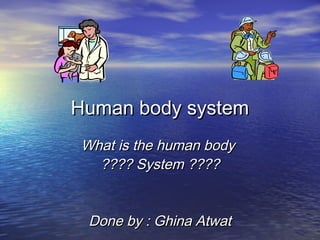
Human Body System
- 1. Human body system What is the human body ???? System ???? Done by : Ghina Atwat
- 2. systems Several different systems make up the human body Every minute of everyday different systems work together as a team to keep you alive and healthy You probably know that you have a heart, stomach, and two lungs. each of those parts are called organs Each organ in your body has it’s own job to do Each of your body systems is made out of organs. Your heart is an organ in the circulatory system. Your stomach is an organ of the digestive system. Your lungs are organs of your respiratory system.
- 3. Cells tissues and systems • Other body systems are: skeletal system, muscular, and nervous system. All organs in your body work together and depend on each other. • Each organ in your body is made out of two tissues or more kinds of tissues • In fact, all living things are made out of cells • You have hundred different kinds of cells. Muscle cells, nerve cells, and bone cells. • Muscle cells form muscle tissue. Muscles change shape to help you move.
- 4. Tissues Nerve cells form nerve tissues. Your brain and nerve are both made out of nerve tissues Bones and muscles The bones in your skeleton give you shape. Your bones also support you Bones also work with your muscles to help you move the way you do Parts of your skeleton also protect softer organs Your skull which protects your brain
- 5. Bones and muscles The ribs form a cage which protects your heart and lungs Cartilage When you were born, your body was mostly made out of rubbery tissues called “cartilage”. As we grow, some of the bones start to replace most of the cartilage. However, some cartilage remains. For example, your ear and the tip of your nose are made of cartilage.
- 6. X-rays pictures called “x-rays” help doctors see broken bones Because tissues are living, broken bones can heal A cast holds a broken bone in the correct position while it mends New bone cells begin to form The place where two bones of the skeleton meet is called the “joint”
- 7. X-rays Joints allow movement. They give your skeleton it’s ability to bend, twist and turn. You have hinge joints in your elbows and knees. Muscles A muscle is a tissue that is made out of muscle cells. Muscles have the job to make other body parts move. Muscles also give your body it’s shape and protect soft organs inside you. Muscles can move bones because muscle cells change their shape This is why muscles work in pairs. One muscle pulls a bone one way. Another muscle pulls the bone the opposite way.
- 8. Muscles • When biceps contract they pull the hand towards the shoulder. The arm bends. When the triceps contract, the muscles pull the arm away from the shoulders. The arm straitens out. Kinds of muscles • Arm muscles arm kinds of muscles • Certain other muscles are : involuntary muscles. They work even when you sleep. For example, the muscles that move food through your digestive system are involuntary muscles.
- 9. Exercises 1- Say two jobs that body systems do. 2- Name one organ in each of these systems : circulatory, digestive, and respiratory system. 3- What are organs made of ? What are tissues made up of ? 4- How does the skeletal system help your body ? 5- How does a broken bone heal ? 6- What are the differences between two kinds of muscles ? 7- Why is it important that your heartbeats and breathing are controlled by involuntary muscles ? 8- How do joints help you move ? 9- What are two things muscles do ? 10- How do muscles help you move ?
- 10. Answers 1- Breathe in and out (respiratory) helps you read and think (nervous). 2- Circulatory: heart respiratory: lungs digestive: stomach 3- Organs are made of different kinds of tissues. Tissues or made of different cells. 4- The skeletal system give your body it’s shape and support your body. (holds your body) 5- Because it’s a living tissue, it can heal. 6- Some muscles are involuntary and other are voluntary muscles
- 11. Answers (7—10) 7- It is important that our heart muscle is involuntary so that it can still work in activities such as sleeping. 8- Joints give the ability to bend, twist and turn. 9- Muscles help us move and protect our softer organs. 10- Muscles work in pairs and in action opposite too each other
